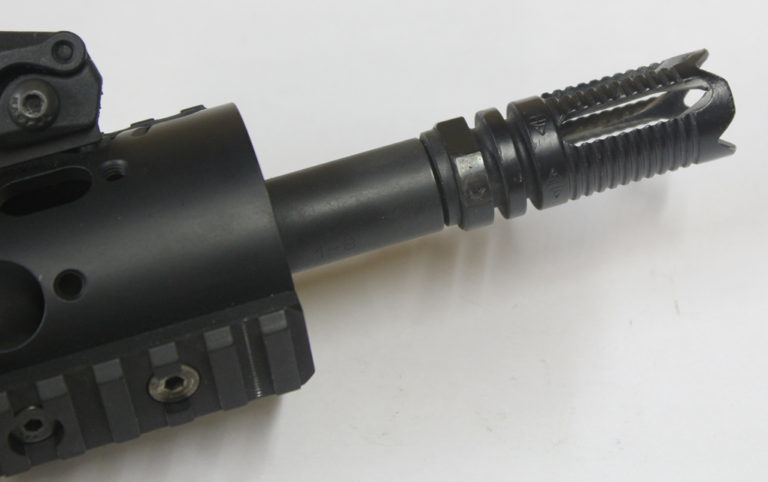
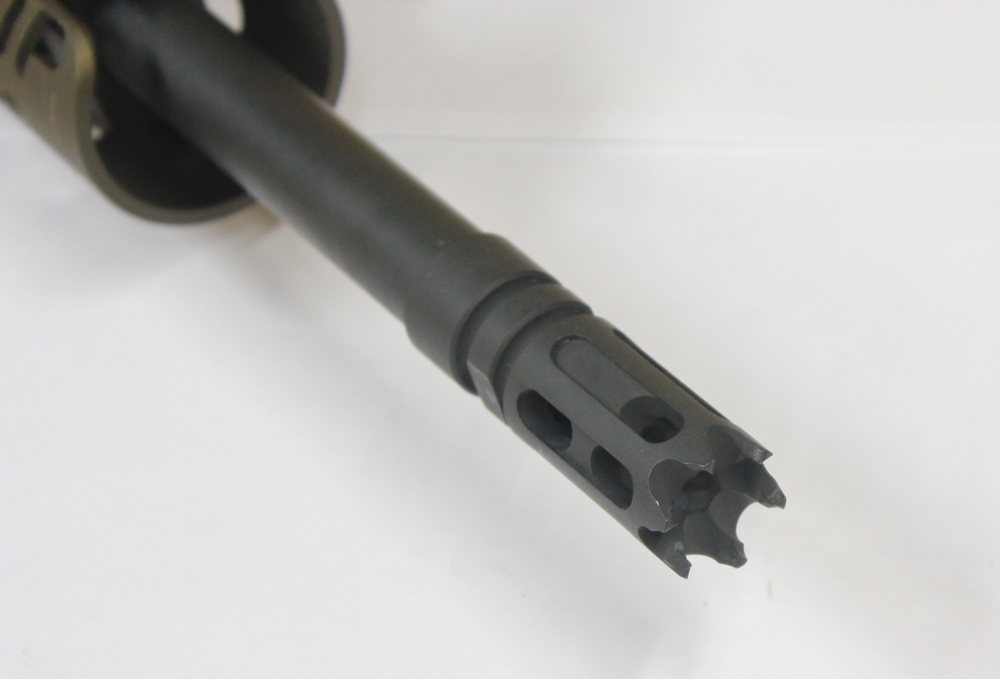
The right muzzle device — whether it's a flash hider, compensator or muzzle brake — is an often-overlooked feature when shopping for an AR. But it shouldn't be, as each enhances the rifle in its own way. Understanding and selecting the right option for your black gun can go a long way in making a more effective firearm.
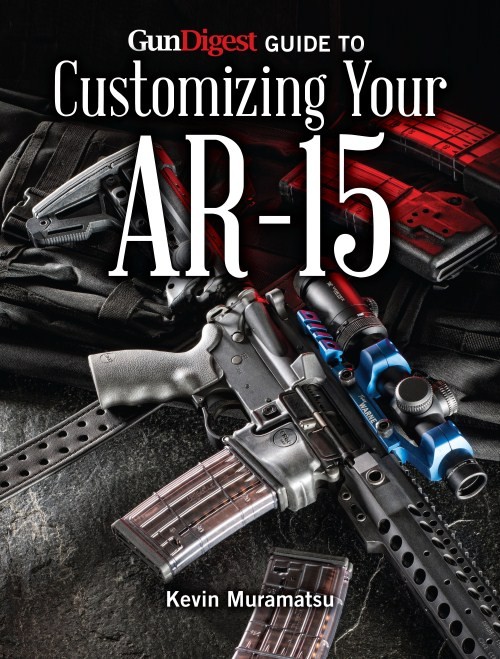
Flash Suppressor
A flash suppressor or flash hider reduce the muzzle flash caused by still-burning powder exiting the barrel behind the bullet. Some powders have flash retardants in them, so a smaller signature will be seen. Others are naturally bright, and using ammo with these powders will create quite the bloom when fired. Furthermore, rifles with muzzle brakes attached tend to flash brightly, but in a more directional manner.
Here’s an example. I once conducted an experiment to see how effective a couple of these were. Now this wasn’t a truly scientific experiment, but it still was pretty definitive. I shot my 16-inch carbine nekkid muzzle, with a standard A2 flash suppressor, and with a Yankee Hill Machine Phantom 5C2 flash suppressor. I did this around 8 p.m. in the autumn, dark enough that there was little ambient light. The ammo used was Winchester 5.56 (Q3131A for a part number if you care), made in Israel for Olin Industries (owns Winchester name for ammo), known for producing a bright flash.
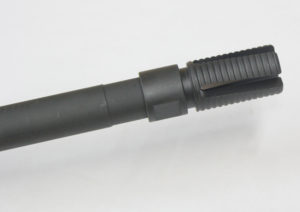
The first shot with the nekkid muzzle produced an orange basketball-sized globular flash. It was bright and did in fact disrupt the night vision I had at the time. I followed this up with the Mil-Spec A2 flash suppressor on the muzzle.
The result when fired was a small orange flash about the size of the average Clementine orange. Then I fired with the Phantom and I was duly impressed. There was no flash visible to me or the observers (my extended family), but there was a single spark that traveled a few feet from the muzzle before extinguishing. A. Spark.
Anyone within several hundred meters would have seen the nekkid muzzle flash, and within at least a hundred meters would have seen the A2 flash. I doubt anyone within as little as 20 feet would have seen the spark and they would have had to have been looking directly at me to even catch a glimpse of it.
The Phantom, at least that model, is a superb flash suppressor and it is even pretty affordable. You can get one for under thirty bucks, and there are several models that have closed bottoms so you don’t kick up dust when firing prone. They work just as well as the standard models. They are similar to the A2 flash suppressor, which also has five open ports on the top and sides, but has a closed bottom. They have the added minor benefit that they combat muzzle rise slightly like dedicated muzzle compensators.
Back when I tried this, the only options were the Mil-Spec A1 (six evenly spaced ports), A2, the Phantom and the Vortex (Smith Industries) and the copies thereof. Now, you’ll get a headache trying to figure something out and you will ultimately probably decide based purely on the aesthetics of the device.
Get More Suppressor Info:
- The Suppressor: How Is It Made, It Works And How To Buy One
- Best AR-15 Suppressor Options For A Quiet Advantage
- Handgun Gear: Best 9mm Suppressor Choices
- Best .22 Suppressor Choices To Mute Your Plinker
There are a number of well-functioning flash suppressor on the market now, though the best seem to be variants of the Phantom or the Vortex. The Vortex has long tines similar to the Phantom, but the tines are not connected at the end. This allows the tines to vibrate like a tuning fork when the gun is fired, and this is the mechanism to disperse the flash. These types of flash hiders are arguably the most effective designs, but also tend to approach $50 in cost. You also have to watch where your muzzle goes (you already do anyway, right) or you might get stuff stuck in between the tines.
Compensators
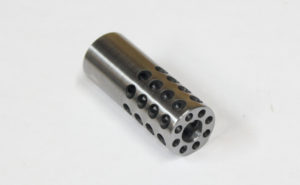
The term compensator is almost always ascribed to a muzzle device that is designed to reduce muzzle rise, not necessarily recoil. Indeed, if the device pushes the muzzle down, more recoil force is often transmitted straight back, enhancing felt recoil while keeping the muzzle movement minimal. It is true, however, that compensators and muzzle brakes can be combined effectively in the same unit, and we’ll talk about those in the following section on muzzle brakes.
The vast majority of compensators are designed with a common element of holes or slots on the top. These slots may extend somewhat to the side but then they become more like brakes. When the bullet exits the barrel and passes through the compensator, the expanding gas behind the bullet exits through these holes before exiting the “muzzle” of the comp. This produces a jet of gas that is going straight up or up and to the rear, acting as a counterforce to the rise of the muzzle. The higher the pressure of the gas behind the bullet the more effective the comp.
The A2 flash suppressor also acts as a compensator, where the older A1 flash suppressor did not. Many companies, in particular YHM, make compensator or brake versions of their flash suppressors that look virtually identical.
Muzzle Brake
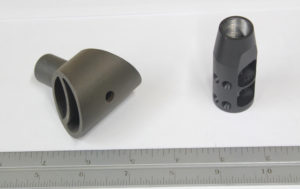
Brakes are designed a bit differently and are typified by the inclusion of baffles in the design. They work by using the expanding gas, as the compensator does, but in a different manner. These are designed to reduce felt recoil, not necessarily muzzle rise.
To do this, they have what amounts to virtual expansion chambers formed by the baffles. When the expanding gas following the bullet hits the rear face of the baffles, the gas literally pushes the baffles, the brake and the rifle it is attached to, forward. The gas then vents out the large holes on the side of the brake.
Most brakes also incorporate a few holes on the top to vent some of the gas up, giving them very good muzzle compensation in addition to the braking. You will see these in variations of two basic designs. The first is simply a hollow cylinder, bored out with dozens of holes all the way around the outside of the comp. These are reasonably effective as long as there is a front face to deflect some of the gas out, and are typified by the Williams muzzle brakes.
The second type is much larger and will have the large flat baffles and large side vent ports and most of these work incredibly well. The JP Enterprises, Dreadnought Industries and other similar models are very popular in the varminting and sporting realms because of the ease of follow-up shooting.
A very important note must be made. Compensators and muzzle brakes are so loud that you must have hearing protection. Do not shoot these guns indoors if you can help it. The concussion on these can be quite powerful and much of it is directed to the side or rear. Do not teach new shooters, especially women (who seem to be particularly sensitive to concussive effects) to shoot with centerfire rifles equipped with these muzzle devices.
On the other hand, if you are at the range and you have a couple stupid couch commando tough guys next to you (you know the type, too tough to wear sissy hearing protection, and smells like he hasn’t showered in an week), you can get rid of him quickly by getting out your compensated rifle and ripping off five or six shots one right after the other. He will quickly want to be elsewhere.
This article is an excerpt from Gun Digest Guide to Customizing Your AR-15.

Next Step: Get your FREE Printable Target Pack
Enhance your shooting precision with our 62 MOA Targets, perfect for rifles and handguns. Crafted in collaboration with Storm Tactical for accuracy and versatility.
Subscribe to the Gun Digest email newsletter and get your downloadable target pack sent straight to your inbox. Stay updated with the latest firearms info in the industry.

![Best Concealed Carry Guns In 2025 [Field Tested] Wilson Combat EDC X9S 1](https://gundigest.com/wp-content/uploads/Wilson-Combat-EDC-X9S-1-324x160.jpg)


![Best 9mm Carbine: Affordable PCCs [Tested] Ruger Carbine Shooting](https://gundigest.com/wp-content/uploads/Ruger-Carbine-Shooting-100x70.jpg)
![Best AR-15: Top Options Available Today [Field Tested] Harrington and Richardson PSA XM177E2 feature](https://gundigest.com/wp-content/uploads/Harrington-and-Richardson-PSA-XM177E2-feature-100x70.jpg)
